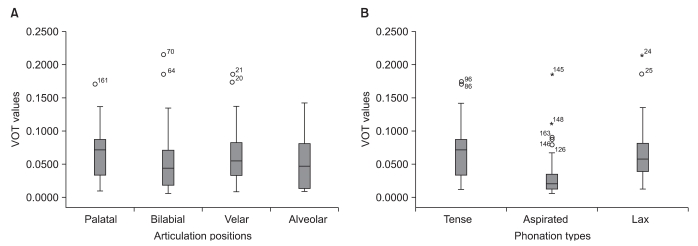Ann Rehabil Med.
2011 Oct;35(5):694-700. 10.5535/arm.2011.35.5.694.
Voice Onset Time Variations of Korean Stop Consonants in Aphasic Speakers
- Affiliations
-
- 1Department of Speech & Rehabilitation, Hyejeon University, Hongseong 350-702, Korea.
- 2Department of Physical Medicine and Rehabilitation, Chonbuk National University Medical School, Jeonju 561-180, Korea. mhko@chonbuk.ac.kr
- 3Department of Clinical Speech Pathology, Chonbuk National University, Jeonju 561-180, Korea.
- KMID: 2267232
- DOI: http://doi.org/10.5535/arm.2011.35.5.694
Abstract
OBJECTIVE
To compare the voice onset time (VOT) differences of Korean stops in the initial and intervocalic positions between the aphasic patients with peculiarities of aspiration and a control group. METHOD: We examined 15 aphasic patients (nine males, six females) who had suffered a stroke (average age 49.7 years) and 15 healthy controls (average age 47.4 years). An aphasia examination was made by an aphasia battery of three standard tests and VOT was analyzed instrumentally. Stop consonants in the initial and intervocalic position were measured to categorize them according to aphasia types, place of articulation, and manner of articulation.
RESULTS
VOT of the aphasic patients with peculiarities of aspiration had a greater difference than that of the controls, indicating that the temporal non-coordination between the laryngeal adjustment and oral articulators of aphasic patients happens due to the VOT of stops in the initial and intervocalic positions (p<0.05).
CONCLUSION
VOT of stop consonants in the initial position produced by aphasic patients tends to be proportional to their breathing. It can cause glottal width and make aphasic patients' VOT duration longer. Lastly, the method to measure the VOT of aphasic patients is more significant for the types of phonation than for the places of articulation, and makes it possible to induce abnormal VOT.
Keyword
MeSH Terms
Figure
Reference
-
1. Rosenbek JC, LaPointe LL, Wertz RT. Aphasia: a clinical approach. 1989. 1st ed. Boston: Pro-Ed.2. Hegde MN. A coursebook on aphasia and other neu rogenic language disorders. 1994. 2nd ed. San Diego: Singular Publishing Group.3. Brookshire RH. Introduction to neurogenic communication disorders. 2007. 7th ed. St Louis: Mosby Elsevier.4. Caplan D, Futter C. Assignment of thematic roles to nouns in sentence comprehension by an agrammatic patient. Brain Lang. 1986; 27:117–134. PMID: 3947937.
Article5. Kent RD, Kent JF, Rosenbek JC. Maximum performance tests of speech production. J Speech Hear Disord. 1987; 52:367–387. PMID: 3312817.
Article6. Koenig LL. Distributional characteristics of VOT in children's voiceless aspirated stops and interpretation of developmental trends. J Speech Lang Hear Res. 2001; 44:1058–1068. PMID: 11708527.
Article7. Adams SG, Weismer G, Kent RD. Speaking rate and speech movement velocity profiles. J Speech Hear Res. 1993; 36:41–54. PMID: 8450664.
Article8. Grigos MI, Saxman JH, Gordon AM. Speech motor development during acquisition of the voicing contrast. J Speech Lang Hear Res. 2005; 48:739–752. PMID: 16378470.
Article9. Japan society of high tea brain. Standard Language Test of Aphasia. 2003. Tokyo: Sinheunh Medical Press.10. Schuell H. Differential diagnosis of aphasia with the minnesoto test. 1997. Minnesota: University of Minnesota.11. Goodglass H, Kaplan E, Barresi B. Boston diagnostic aphasia examination. 2000. 3nd ed. Pennsylvania: Penny-Lea&Febiger.12. Kim HG, Shin HK. VPI Articulation differential examination. 2001. Jeonju: Research Institute of Speech Science Press.13. Grigos MI. Changes in articulator movement variability during phonemic development : a longitudinal study. J Speech Lang Hear Res. 2009; 52:164–177. PMID: 18664683.14. Klatt DH. Voice onset time, frication, and aspiration in word-initial consonant clusters. J Speech Hear Res. 1975; 18:686–706. PMID: 1207100.
Article15. Weismer G. Philosophy of research in motor speech disorders. Clin Linguist Phon. 2006; 20:315–349. PMID: 16728332.
Article16. Koenig LL. Distributional characteristics of VOT in children's voiceless aspirated stops and interpretation of developmental trends. J Speech Lang Hear Res. 2001; 44:1058–1068. PMID: 11708527.
Article17. Lofqvist A. Acoustic and aerodynamic effects of intera rticulator timing in voiceless consonants. Lang Speech. 1992; 35:15–28. PMID: 1287385.18. Zlatin MA, Koenigsknecht RA. Development of the voicing contrast: a comparison of voice onset time in stop perception and production. J Speech Hear Res. 1976; 19:93–111. PMID: 1271805.
Article19. Baum SR, Blumstein SE, Naeser MA, Palumbo CL. Temporal dimensions of consonant and vowel production: an acoustic and CT scan analysis of aphasia speech. Brain Lang. 1990; 39:33–56. PMID: 2207620.
- Full Text Links
- Actions
-
Cited
- CITED
-
- Close
- Share
- Similar articles
-
- The Phonetic Characteristics in Patients of Bilateral Vocal Fold Paralysis Without Tracheotomy
- Vowel Context Effect on the Perception of Stop Consonants in Malayalam and Its Role in Determining Syllable Frequency
- An Acoustic Study on Voice Change after Tonsillectomy
- Effect of Vowel Context on the Recognition of Initial Consonants in Kannada
- Acoustic and Electromyographic Characteristics of Fluent Alaryngeal Speech



